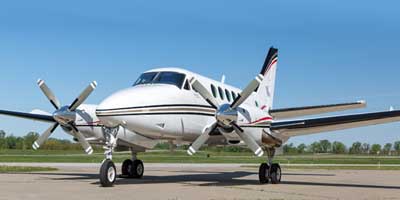
Beech King Air 100
The Beech King Air 100 was produced by Beechcraft between the years 1969 and 1983, Serial numbers B2 through B89,93. It is a twin-engine turboprop aircraft configured as a cantilever low-wing aircraft with a conventional Tail. Pressurization, retractable landing gear and constant-speed, auto feathering, reversible propellers are features of the Model 100. A combination of configurations are available with club and divan seating, but seating for eight passengers and 1 pilot is most common.
Specifications
Exterior Dimensions
Wing span: 45 ft 11 in
Length: 39 ft 11 in
Height: 15 ft 5 in
Interior Dimensions
Cabin Height: 4 ft 8 In
Cabin Width: 4 ft 8 in
Cabin Length: 12 ft 8 in
Cabin Volume: 355 cu ft
Internal Baggage: 55 cu ft
Weights
Max TO weight: 10,600 lb
Empty Weight: 6,780 lbs
Maximum Payload: 2,270
Fuel capacity: 373 gal
Engine
Manufacturer: Pratt & Whitney
Model: PT6A-28
Horsepower: 680 hp
Overhaul (HT): 3600hr TBO
Standard Avionics
Dual Nav/Coms
Terrain Awareness System B
Autopilot and Radar
ADS-B
Performance
| Horsepower: 680.00 | Gross Weight: 10,600 |
| Top Speed: 250 | Empty Weight: 6,780 |
| Cruise Speed: 235 | Fuel Capacity: 373 |
| Stall Speed (dirty): 75 | Range: 1,005 nm |
| Rate of Climb: 2,200 fpm | Rate of Climb (One Engine): 608 |
| Service Ceiling: 31,000 | Ceiling (One Engine): 11,800 |
| Takeoff | Landing |
| Ground Roll: 1,452 | Ground Roll 1,240 |
| Takeoff Roll Over 50 ft: 1,729 | Landing Roll Over 50 ft: 2,138 |
History (Wikipedia)
The Model 100 King Air is a stretched derivative of the Model 90 featuring five cabin windows instead of the Model 90's three; MTOW increased by 1,300 lb over the 90, to 10,600 lb. Beech used the wings, tail, and engines (two PT6A-28 engines, although rated at 680 shp) from the Model 99 airliner, itself a development of the Queen Air (as was the Model 90).
On March 17, 1969, the first King Air 100 was flown and unveiled to the public in May. 89 Model 100s were built before it was superseded by the Model A100 in 1972, with a further increase in MTOW to 11,500 lb, fuel capacity increased by 94 US gallons, and four-bladed propellers. A total of 157 A100s were built by the time production of this model ceased in 1979.
Further Production
Next in the series was the B100, which featured 715 shp Garrett AiResearch TPE-331 engines as an alternative to the Pratt & Whitneys offered on other King Airs, and another increase in MTOW to 11,800 lb (5,350 kg). Model B100 was introduced in 1976 and was produced concurrently with the Model A100 for several years; manufacture ceased in 1983 after 137 were built. Beech developed the Model 200 Super King Air was from the Model 100, with the same fuselage design (with some differences, mainly associated with the different tails) being used for both models. The Model 200 had different wings and a T-tail and entered service in 1974.
Variants
Beech King Air 100 (1969-1971) Serial Numbers B-2 through B-89, B-93
B90 with a 50-inch fuselage stretch, larger vertical tail, two 680shp PT6A-28 engines, first flown in 1969, 89 built.
Beech King Air A100 (1972-1979) Serial Numbers B-90-92, B-94 through B-247
Model 100 with additional fuel capacity, four-bladed propellers and two extra side windows, 157 built.
Beech King Air A100-1
Designation for procurement reasons of three Model 200 battlefield surveillance variants for the United States Army as the RU-21J.
Beech King Air A100A
A100 with PT6A-28A engines and 11800lb TOGW.
Beech King Air A100C
A100A with 750shp PT6A-36 engines.
Beech King Air B100 (1976-1983) Serial Numbers BE-1 through BE-137
A100A with two 715shp Garrett TPE-331 engines instead of Pratt & Whitney PT6s fitted to previous models; 137 built.
Beech King Air C100
B100 with 750shp PT6A-135 engines.

